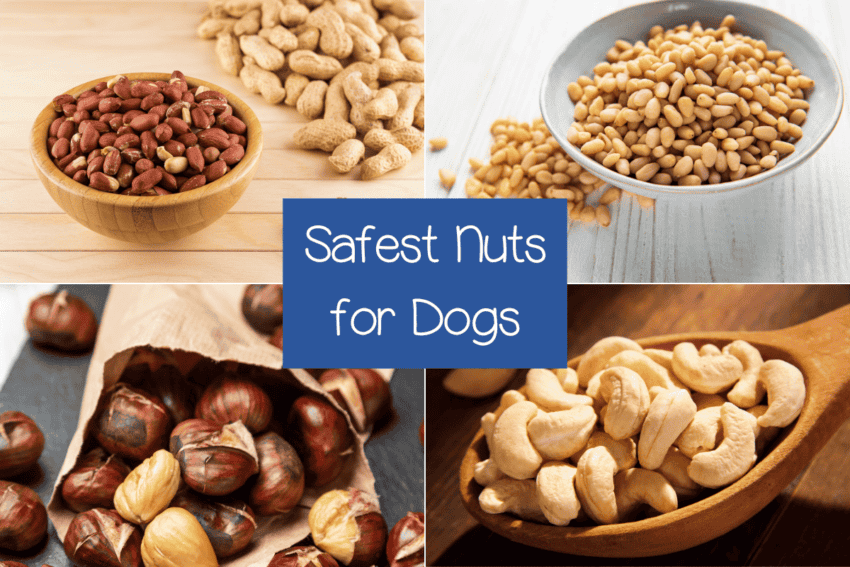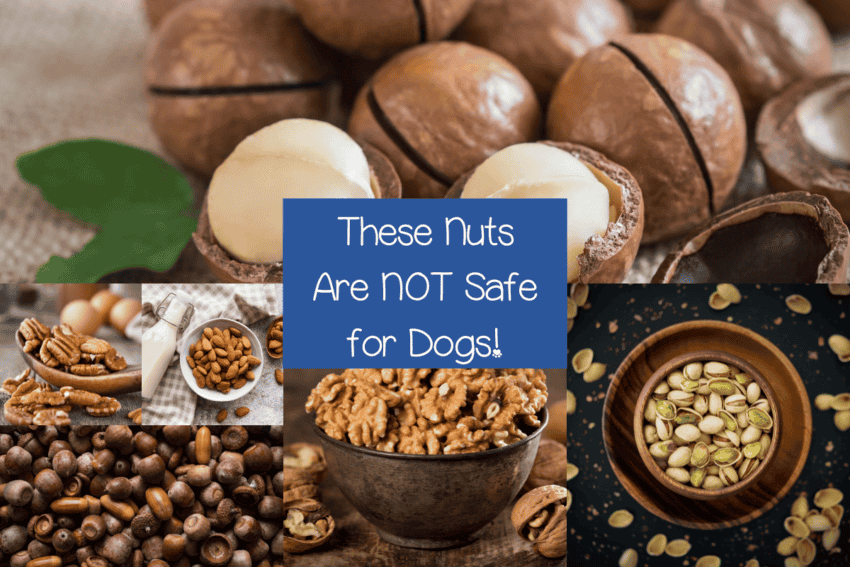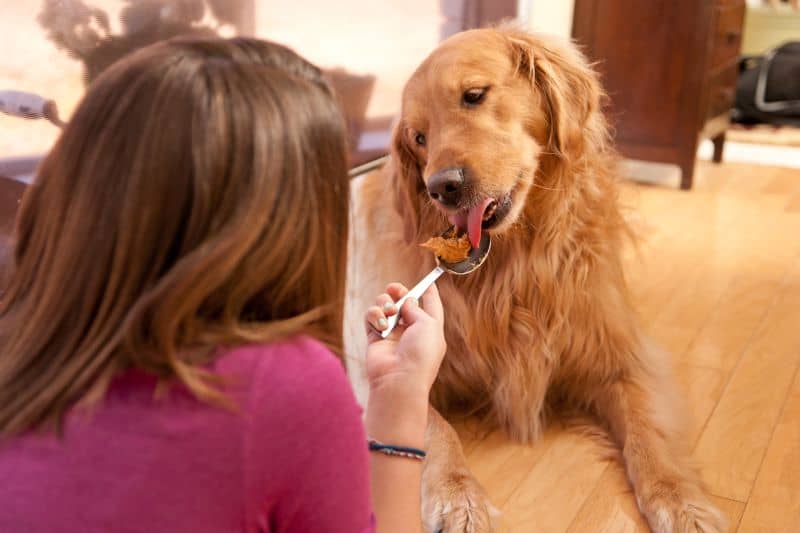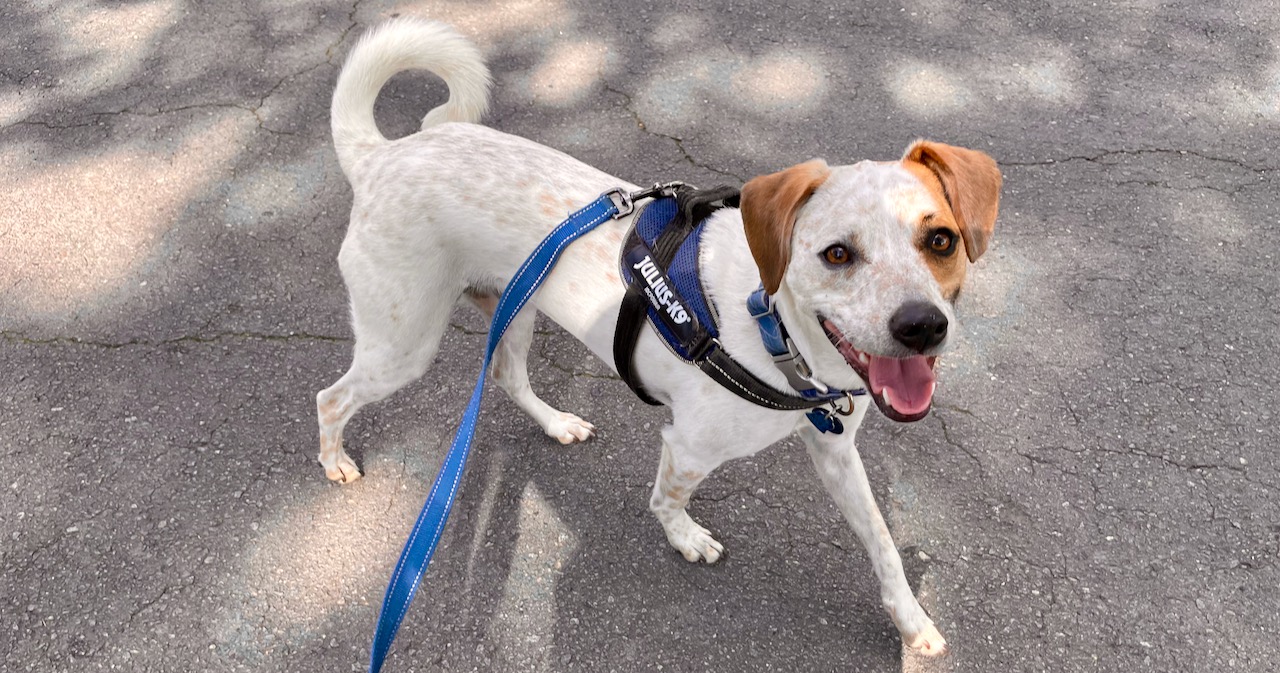Can dogs eat nuts? If so, which ones are safe, which are so-so, and which nuts should dogs never, ever eat at all?
Are you wondering what nuts can dogs eat to see if they can make your pup’s diet a bit more exciting? It’s a common thought among dog owners, considering how valuable nuts are to our diets. Today, I’ll answer this question by discussing whether it’s a good idea, what nuts are considered safe/not safe, and other must-know nutty topics.
You’ll soon have everything needed to decide whether adding nuts to your dog’s diet is a good idea or not. So read on!
Can Dogs Eat Nuts?
Short answer: yes, dogs can eat nuts, but they aren’t the healthiest option for them. So nuts shouldn’t be your first choice when choosing a new exciting dog treat. But some types provide minimal risk if you’re dead set on using them.
However, you must ensure you use these safe ones, as some nuts are highly toxic. Using the toxic ones will end up with your dog in the vet’s office, which nobody wants. It’s also vital to remember that any provided nuts should be free of additives.
If you stick with the safe ones, they’ll even offer some benefits, as discussed in the next section. After all, we wouldn’t be having this conversation if there weren’t some advantages to dogs eating them.
You may also like: Can Dogs Eat Mango?
What Benefits Do Nuts Provide Dogs?
Nuts do provide valuable benefits for dogs. It’s why many people use them as a treat option. Here’s a quick list to help you decide whether it’s a good idea for your pup:
- Nuts provide a substantial amount of protein. Your dog requires protein to thrive and live a healthy, comfortable life.
- Fiber is another area where nuts can come through in a pinch. Their high-fiber content can help with digestive issues, such as constipation.
- Nuts contain many essential vitamins like B1, B2, and C. These are crucial to keeping your dog in good shape and healthy.
- Certain types of nuts can help reduce blood pressure.
- Nuts promote better blood circulation with amino acids, particularly arginine. After all, arginine is crucial in creating nitric oxide, which is vital in healthier blood flow.
Are Nuts Good for Dogs?
So I just laid out several ways a dog can benefit from nuts in their diet. But still, nuts aren’t known for being a top-tier food item or even good for puppers. It stems from them having several disadvantages, such as a high-fat content and being hard to digest for some dogs.
The digestion part is what put me off using nuts for my dogs. It could lead to pancreatic issues, which are costly conditions to treat. Similarly, some nuts can cause obstruction issues, especially for smaller dogs or ones who get overly excited when eating their food.
Owners must also be careful about feeding their dogs salted nuts. These items can cause your dog to suffer from water retention issues and other conditions. So if you do give them nuts, stick with unsalted and unseasoned options.
Given these issues, owners using nuts should only provide small amounts. These smaller portions will minimize the risks while delivering the potential benefits. I’ll give some tips about feeding dogs nuts later in this article.
But again, you should choose healthier alternatives if possible. Several other treat options are better suited for a dog’s diet. Check out this article to get a better idea of some alternative choices!
4 Safe Nuts for Dogs
As I mentioned, certain nuts provide a more limited risk than others. Anyone intending to feed their dogs nuts should stick with the following four types. Each one is safe and provides at least some benefits for dogs.

1. Peanuts
Peanuts (considered legumes) are your first option when looking at safe types of nuts for dogs. They’re probably the nuts you were thinking about when clicking on this article. They seem like a suitable and fun treat for your pups.
The good news is that peanuts are certainly considered safe for dogs. But they do have the drawback of providing incredibly high-fat content. So too many peanuts could put severe pressure on your dog’s gastrointestinal system.
As a result, stick with only using peanuts in moderation. But it must be an unseasoned or boiled peanut to ensure no potential issues. I use them about once a month as a special treat for my babies.
I take the peanut from its shell and cut it into small pieces. From there, I sprinkle them into my dogs’ kibble to spice up their dinners. It’s gotten to the point where my dogs seem slightly disappointed if there aren’t any peanuts in their food.
I must acknowledge that peanuts do have a risk of causing obstructions. They aren’t a good idea for smaller pups or dogs who eat exceptionally quickly. So any pug owners reading this article would be wise to avoid peanuts even as a special treat.
Is Peanut Butter Safe?
Peanut butter can be safe for dogs, but there are specific rules to follow. You can’t simply whip out a spoon and feed them from any jar of peanut butter. It has to be the right type, or severe consequences could occur.
So you’ll need to look closely at the provided ingredients. Avoid using peanut or nut butter filled with sugars, seasoning, salts, or anything artificial. These ingredients will cause some gnarly issues for your puppy’s tummy.
Likewise, never use any peanut butter with Xylitol among its ingredients. It’s an artificial sweetener that some peanut butter manufacturers use to reduce sugar content. However, it’s incredibly toxic to dogs and can quickly make them sick.
It can even cause severe conditions like seizures or significant vomiting. Therefore, it’s vital to read the ingredients of your peanut butter jar to ensure it doesn’t contain it. Otherwise, a trip to the vet will be the next thing that you’ll do.
Once you find the proper peanut butter, your dog can take some off a spoon. This method is handy when giving my Pitbull her thyroid medicine. The only problem is that it’s the only way she’ll take it now.
2. Pine Nuts
When thinking about potential treats, pine nuts won’t cross many people’s minds. But they’re acceptable options in minimal amounts as they aren’t toxic. So you don’t have to panic if your dog manages to get a hold of a pine nut or two.
It gets problematic if they get into a large quantity, though. Pine nuts are known for their high-fat content and containing phosphorus. Both these ingredients combined can spell trouble for your dog’s stomach and urinary tract.
So overall, there are better treat options for your pupper. But one that can mix things up if provided in small amounts.
3. American Chestnuts
American chestnuts (not horse chestnuts) are an exciting addition to this list. If they’re roasted in small portions, your dog can munch on them without any problem. It’s not an everyday snack, but you can pop them into the food bowl every month or two.
But again, it’s crucial to cut them down into small portions and ensure they’re roasted. American chestnuts are much larger than most other nuts, so they represent a choking hazard when uncut. Honestly, small-breed owners should stay away from them entirely.
4. Cashews
As with chestnuts, cashews are a safe choice for dogs if they’re roasted. They provide the same issues, too, considering they’re another larger type of nut. So you must be careful about portion size to avoid choking and intestinal blockages.
Cashews do provide a high degree of protein, so they’ll benefit your doggo’s diet. But it must be in small doses and positions to ensure problems don’t present themselves. Common issues associated with large quantities of cashews include:
- Promoting obesity with high fat and calorie content
- Upset stomachs
- Pancreatitis
- High levels of potassium could cause urinary tract issues
All in all, one of the more beneficial nut types for dogs. But still not a top-tier new treat option because of limited portions and potential risk factors.
7 Nuts to Avoid for Dogs
So since I’ve covered the safer nuts, let’s look at the other side. It’s time to discuss what nuts should never be given to dogs under any circumstances. These discussions will ensure you don’t make a mistake when trying to spice up a dog’s diet.

1. Macadamia Nuts
Macadamia nuts are one of the most dangerous food options for dogs. It doesn’t matter how you intend to prepare them; these nuts remain a toxic nightmare. Pet owners should keep all macadamia nuts under lock and key inside their homes.
If your dog does manage to poison itself with some, it’ll often cause diarrhea and vomiting. You may also see general leg weakness that’ll get worse and worse. So it becomes essential to see a vet as soon as possible.
2. Pecans
There’s some debate about whether pecans are safe or not for dogs. But I lean toward the unsafe side because they’re pretty prone to mold. If your dog consumes a moldy pecan, it can cause liver damage, seizures, or nerve damage.
Of course, these issues only occur when a dog eats massive quantities. But even one or two pecans have been known to cause upset stomachs. Therefore, I always advise avoiding them altogether.
3. Acorns
Acorns are a compelling addition to this list because I doubt many owners consider including them in a dog’s diet. But your dog will encounter acorns when walking around a park or similar areas.
So it’s vital to ensure they don’t eat acorns because they’re quite hazardous. Large quantities of acorns can cause oak poisoning, while a singular one is a choking and blockage hazard. Due to this, it’d be wise to remain vigilant when walking your pup.
4. Almonds
Almonds are relatively safe, but they do cause some issues. For instance, a dog’s digestive system won’t process them well, leading to upset stomach and diarrhea. So it’s not something that you want your dog to experience.
Furthermore, almonds are one of the larger nut types. It makes a unique hazard for dogs, especially for smaller breeds. The shape also isn’t too convenient, with a probability of getting stuck in your dog’s digestive tract.
Given this info, keeping almonds out of your dog’s diet is best. But there’s no need to panic if they manage to scoop up one or two off the floor. They shouldn’t have many issues since almonds aren’t toxic.
5. Walnuts
As pet owners, walnuts aren’t a food product to consider in a dog’s diet. Consuming them can cause a dog several issues, such as nausea or neurological problems. These nuts have also been known to wreak havoc on stomachs and the entire digestive system.
It’s worth noting that the symptoms don’t have a specific timetable. Some dogs will develop them immediately, while others could see issues a week later. All in all, walnuts are clearly a dangerous and must-avoid item for our puppers.
6. Pistachios
As with pecans, there is a debate among dog owners about pistachios. I find myself avoiding them due to them picking up mold quickly. Some severe issues can arise from this mold entering your dog’s body, like liver failure or other sickness.
Pistachio shells are also a problematic blockage/choking issue for dogs. Considering that’s how they’re most likely to consume them, it’s easy to see why: their owner drops one before cracking it, and they pick it up off the floor.
7. Horse Chestnuts
The last one is a given, but horse chestnuts are incredibly toxic. Every part of the horse chestnut tree is considered poisonous for dogs and humans. It’s just not a tree or nut that you want near your pooch.
How to Feed Your Dog Nuts Safely
Feeding nuts to your dogs requires some precautions, even when using safe ones. It’s vital to follow all these guidelines to ensure an issue-free experience:
- Never Serve Nuts with Shells on Them: Nutshells are the primary culprits of choking and blockage hazards. It also doesn’t help that nutshells have sharp edges, either, which could cause damage to the digestive system.
- Stick with Small Portions: Serving them in limited portions is necessary when adding nuts to a dog’s diet, even temporarily. Their high fat and calorie levels make it essential to prevent obesity and, in extreme cases, pancreatitis.
- Avoid Using Nuts with Any Seasonings: Nuts sprinkled with seasonings like spices, salts, or sweeteners are entirely out of the question. Your pooch won’t gain anything from them or digest them properly. Stick with unsalted, unseasoned, or even roasted nuts if you intend to use them.
- Mix the Nuts in Your Dog’s Food: It’s a much better idea to cut up the nuts into small pieces and mix them into dry kibble. Serving nuts alone might make your dog eat them too fast, causing digestive problems.
- Be Wary of Any Fungus or Mold Signs: As I mentioned earlier, nuts are a common carrier of molds and fungus, so dog owners should inspect them before serving. I’d also avoid using a package of nuts that have been around too long, as mold often appears on old nuts.
You can also use peanut butter (xylitol-free, of course) in dog treats! Here are a few great recipes to try:

When to Consult a Vet
Dog owners must be aware of what symptoms merit an immediate vet visit. So if your dog presents the following symptoms after eating nuts, get to a vet office ASAP:
- Weakness
- Seizures
- Bloody stool or orange-colored urine
- Limping or other issues walking
- Unwillingness to eat
- Diarrhea
- Bloating
- Vomiting
- Increased/rapid heart rate
- Fever
- Tremors
All of these symptoms are classic nut toxicity signs. So if there’s any indication, don’t hesitate to contact a vet and get everything sorted.

Conclusion
All in all, what nuts can dogs eat? The preferable answer would be none. But if you intend to use a type of nut, stick with peanuts, pine nuts, American chestnuts, and roasted cashews. These options have proven to be a safe choice for dogs when unseasoned and in small amounts.
Remember to leave a comment or two if you have additional questions. I’ll answer each post as soon as possible to ensure you feel comfortable adding or not adding a particular nut to your dog’s diet. Thanks for reading!



